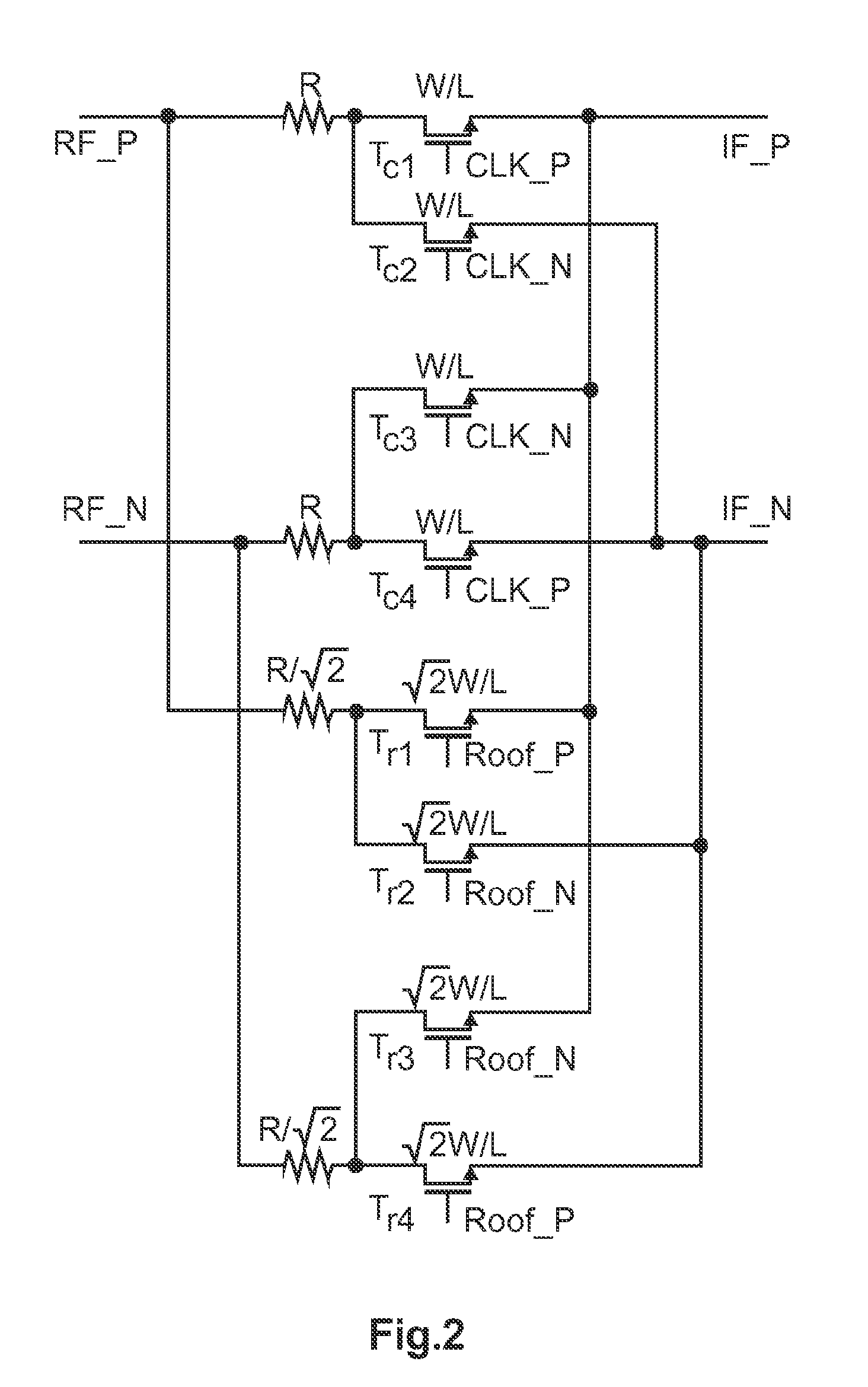Dual-mode mixer circuit and method
a mixer circuit and dual-mode technology, applied in the field of mixer circuit and frequency transformation method, can solve the problems of increasing testing time and hence costs, direct up-conversion architecture suffers from a so-called lo pulling problem, and still exists direct current offset in direct conversion architectures
- Summary
- Abstract
- Description
- Claims
- Application Information
AI Technical Summary
Benefits of technology
Problems solved by technology
Method used
Image
Examples
first embodiment
[0032]FIG. 2 shows a schematic circuit diagram of a mixer circuit in a harmonic-rejection mode. This mixer circuit comprises two NMOS (N-channel metal oxide semiconductor) switching cores, wherein the upper switching core comprises transistors Tc1, Tc2, Tc3 and Tc4 which are fed by 50% duty cycle local oscillator signals of positive polarity (CLK_P) and negative polarity (CLK_N), respectively, and a lower switching core which comprises transistors Tr1, Tr2, Tr3 and Tr4 which are fed by 25% duty cycle local oscillator signals of positive polarity (Roof_P) and negative polarity (Roof_N), respectively. By setting the transistor widths in the lower switching core √2 times the transistor widths in the upper switching core, and the resistance in the lower switching core 1 / √2 times the resistance in the upper switching core, the current yielded in the bottom switching core is √2 times the current yielded in the upper switching core when they are both switched on. Due to the current summin...
second embodiment
[0034]FIG. 4 shows a schematic block diagram of a direct conversion transmitter according to a Similar to the above direct conversion receiver architecture, direct up-conversion is introduced in many applications for transmitter architectures, due to its high level integration option. As shown in FIG. 4, the LO frequency is equal to the carrier frequency, thus eliminating any intermediate up-conversion employed in a dual up-conversion architecture. Therefore, the image problem is no longer present and a high quality factor discrete RF filter in front of a PA 220 can be avoided. In the transmitter architecture of FIG. 4, baseband I and Q components are supplied to respective mixer circuits 240, 242 to which an in-phase component and a quadrature component of a local oscillator signal generated by a VCO 260 is applied. The required phase shift is obtained by a phase shifting circuit 250. Both mixer output signals are summed by an adder circuit 230 and supplied to the PA 220 in order ...
third embodiment
[0042]FIG. 9 shows a schematic circuit diagram of a mixer circuit which can be applied as the mixer circuit 340 of FIG. 8, according to a Additionally, FIG. 9 shows waveforms of the local oscillation signal fVCO generated by the VCO 310 and phase signals f0(t), f1(t), f2(t) and f3(t) to be supplied via the waveform combiner 330 to the mixer circuit 340. Each of four mixers provided in the mixer circuit 340 to translate or transform the frequency of a desired signal from baseband to IF is realized with three active current-commuting sub-mixers all feeding common resistive loads connected to a voltage supply line Vdd, as shown in FIG. 9.
[0043]Each of the three sub-mixers of FIG. 9 receives the same baseband input BB through scaled input devices. However, the switches in each sub-mixer are driven by respective ones of the four phase components generated by the divide-by-four circuit 320 based on the local oscillator signal. Each sub-mixer generates a typical square wave response with ...
PUM
 Login to View More
Login to View More Abstract
Description
Claims
Application Information
 Login to View More
Login to View More - R&D
- Intellectual Property
- Life Sciences
- Materials
- Tech Scout
- Unparalleled Data Quality
- Higher Quality Content
- 60% Fewer Hallucinations
Browse by: Latest US Patents, China's latest patents, Technical Efficacy Thesaurus, Application Domain, Technology Topic, Popular Technical Reports.
© 2025 PatSnap. All rights reserved.Legal|Privacy policy|Modern Slavery Act Transparency Statement|Sitemap|About US| Contact US: help@patsnap.com



